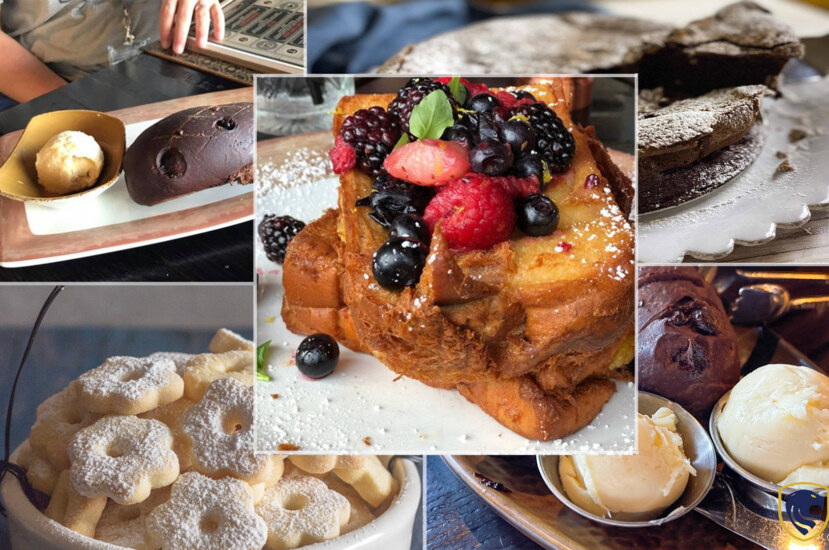Pana Cotta
This flavorsome dessert holds a major place when it comes to Italian Desserts. Panna cotta is frequently recognized as a typical Italian dessert from the Piedmont area, despite its absence from Italian recipes before to 1960. A Hungarian woman who resided in Italy at the start of the 20th century. So goes one legend, devised the dessert. In its list of regional specialties from 2001, Piedmont includes panna cotta.
Warm cream has sugar in it already. The cream can be flavoured by adding rum, coffee, vanilla, and other ingredients. Also it can be made by infusing it with spices. A cold liquid, typically water, is used to dissolve gelatin before it is added to the heated cream mixture. This is put in molds and given time to solidify. The bottoms of the molds could be lined with caramel. It creates a crème caramel-like effect. The panna cotta is often unmolded onto a serving platter when it has solidified.

Although the term refers to “baked cream,” the ingredients are merely heated to the point where the sugar and gelatin are dissolved.
Colla di pesce, or “fish glue,” is a term used in Italian cooking that can refer to either isinglass or regular gelatin.
Italian Cheese: Ricotta
Whey from the milk of sheep, cows, goats, or Italian water buffalo is used to make the whey cheese known as ricotta in Italy.
Ricotta has been made throughout the Italian peninsula since the Bronze Age. Ceramic containers known as milk boilers began to emerge often in the second millennium BC. And were reportedly exclusive to the peninsula. These were created to boil milk at high temperatures without causing it to overflow. These boilers likely used entire milk to manufacture the fresh acid-coagulated cheeses.

There was a surplus of sweet whey produced as a result of the increased rennet-coagulated cheese manufacturing. Cheesemakers then began utilizing a new formula to create the classic ricotta we know today, which included milk and whey.
Another distinction belongs to ricotta, which, like mozzarella, is one of the simplest Italian cheeses to manufacture. And can be produced in a matter of minutes before being served to eager customers. Contrary to common perception, the cheese does not go through further coagulation. That is what makes it so simple. When producing his first cheese, if a cheesemaker adds acid to the whey and more curds rise to the top, he isn’t patient enough. Even yet, a lot of home cheesemakers continue to attempt to curdle the whey. sometimes they get disappointing results.
Canestrelli
Butter cookies called canestrelli have their roots in the Middle Ages. Contrary to common assumption, many traditions have weathered the test of time. And not much has altered since the Middle Ages.

These resemble sugar cookies from Italy much more. They are delicate enough to melt in your tongue, yet with a pleasantly subtle lemon taste and delicious crunch.
What makes these so distinctive then? Well, cooked egg yolk is required in the recipe!
Hard-boiled egg yolks must be prepared, then grated before being included into the dough. Not only will this stop too much gluten from growing. That may make the dough stiff. But it will also inhibit the dough from weighting itself down, making it incredibly light.
Biscotti al cocco
Although the term “biscotti di Prato” is generally used to refer to Prato biscuits, they are also known as “cantuccini” in modern Italy and Argentina. These names really refer to other comparable regional Italian items. Cantuccini is a phrase that is most widely used in Tuscany nowadays. However, it initially referred to changes or imitations that differed from the conventional recipe in a few key areas, such as the use of yeasts, acids, and different kinds of flavorings. Rusks are bigger, lengthier biscuits made from rustic bread dough.They’ve been flavored with olive oil and anise seeds.

The key ingredient in these wonderful, flaky cookies is coconut. Eggs, sugar, butter, and shredded coconut are mixed to make the dough. The dough is then often formed into balls or flat discs. Baked till crisp and golden, biscotti al cocco can be eaten simple or topped with melted chocolate or powdered sugar. There are many alterations to this desserts. We can find many kind of Biscotti al cocco which are Amaretti, Baci di dama, Brutti ma buoni, Tozzetti, and Amaretti di Saronno.
Chocolate Gelato
Gelato, which translates to “frozen” in Italian, is an Italian frozen delicacy that was invented in the 16th century. Historians are unsure who originated it, although one of the most prevalent versions of the narrative is that Bernardo Buontalenti, a Florentine, devised a kind of contemporary gelato.
Gelato can be considered as a food that have come through lots of variations over the time. Bernando Buontalenti is a figure who is said to have emerged on the scene of gelato making in the second half of the 16th century. He was a well-known painter, architect, and engineer, as well as an amateur chef. The iniciation of all of this started with a mixture of eggs and milk.

Gelato and ice cream are quite similar, with the exception that ice cream is lighter on the tongue. In contrast, Gelato has a smooth texture compared to ice-cream as a result of low fat levels.
Unlike ice cream, which is produced with a cream and egg custard foundation. Gelato is created with milk and sugar.
This recipe combines genuine chocolate and cocoa to provide the greatest taste profile.
Classic Pizzelle
This dessert is also known as Italian Waffle Cookies. The oldest cookie still in existence today is a pizzelle, which has its roots in central Italy. They were created many years ago in the Italian town of Colcullo for the “Festival of the Snakes,”. It is also known as the “Feast Day of San Domenico.”
Though these light, waffle-like cookies are delicious. Pizzelle Irons are widely used to obtain the gorgeous patterns that are appearing on pizzelles.

People often fall love with this dessert for how light and crisp these are. And how basic the vanilla flavor is. Of course, you may also flavor them with anise, almond, lemon, or chocolate.
To create the lightest cookie possible, fully whisk your sugar and eggs and just fold in the flour until just combined to avoid overmixing.


